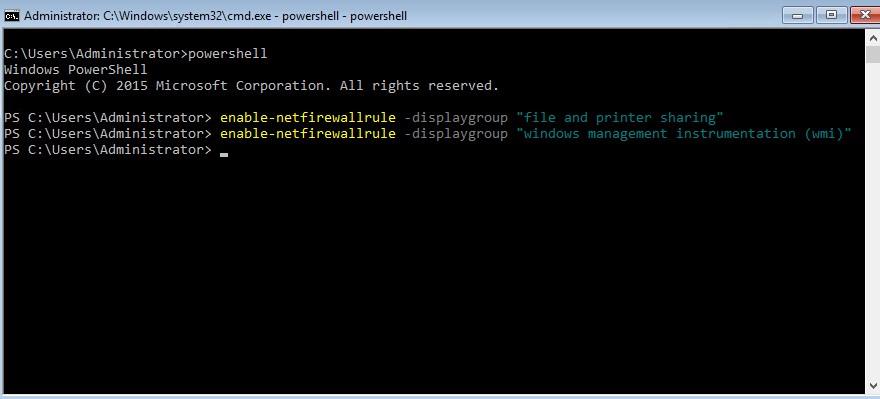Managing the Windows Firewall on Server Core can seem daunting for administrators unfamiliar with the Server Core installation of Windows Server. Unlike the full version of Windows Server, Server Core doesn’t include the traditional GUI (Graphical User Interface), so tasks like configuring the firewall require command-line tools or PowerShell. In this guide, we’ll explore how to effectively manage the Windows Firewall on Server Core, recommend some top tools and products, compare their features, and give you the best transactional advice on where to buy them. Whether you’re a system administrator or an IT enthusiast, by the end of this article, you’ll have a clearer understanding of how to manage firewall security on Windows Server Core with ease!

What is Windows Firewall on Server Core?
The Windows Firewall is a critical component of any Windows operating system, serving as the first line of defense against unauthorized access to your server. When you’re working with Windows Server Core, you’re interacting with a minimal installation that lacks a traditional graphical interface, relying on command-line tools and PowerShell for configuration.
Windows Firewall on Server Core works the same way as it does in other versions of Windows, but managing it becomes more of a challenge due to the absence of a GUI. Server Core, which is often used for running specific server roles (like DNS, Active Directory, or IIS), requires network security configurations to be handled entirely through command-line interfaces or remote management tools.
Key Features of Windows Firewall on Server Core:
- Port Filtering: Control inbound and outbound traffic by filtering specific ports.
- Rule-based Configuration: Define rules to allow or block traffic based on IP addresses, protocols, or applications.
- Logging: Maintain logs to monitor firewall activity.
- Remote Management: Manage firewall rules from a remote workstation using PowerShell or Windows Admin Center.
Why You Need to Manage the Windows Firewall on Server Core
Managing your Windows Firewall on Server Core is essential for several reasons:
- Security: A misconfigured firewall can leave your server vulnerable to attacks from external or internal threats. Proper management ensures your server is secure and only allows traffic that is absolutely necessary.
- Compliance: Many industries require servers to comply with security standards, and firewall rules play a crucial role in meeting these requirements.
- Network Optimization: Properly configured firewall rules can help ensure that only relevant traffic reaches your server, optimizing performance and minimizing unnecessary load.
Failing to manage your firewall on Server Core could lead to exposure to security risks, network slowdowns, or even compliance violations. Therefore, it is crucial to master the firewall management process to safeguard your server and network. 💼
How to Configure Windows Firewall on Server Core
Configuring the Windows Firewall on a Server Core installation can be done through PowerShell or the netsh command line tool. Here’s a simple guide:

Using PowerShell:
- Open PowerShell: Use PowerShell to manage your firewall rules.
- View Current Rules: Use the command
Get-NetFirewallRuleto list current firewall rules. - Enable/Disable Rules: Use
Enable-NetFirewallRule -Name "RuleName"to enable a specific rule orDisable-NetFirewallRule -Name "RuleName"to disable it. - Create a New Rule: Use
New-NetFirewallRuleto add a new rule. For example:powershell - Copy code
New-NetFirewallRule -Name "AllowHTTP" -DisplayName "Allow HTTP Traffic" -Protocol TCP -LocalPort 80 -Action Allow
Using Netsh Command:
- View Existing Rules: Use the
netsh advfirewall firewall show rule name=allcommand to list all existing rules. - Add a Rule: You can add a new rule using
netsh advfirewall firewall add rule name="AllowHTTP" protocol=TCP dir=in localport=80 action=allow. - Delete a Rule: To remove a rule, use
netsh advfirewall firewall delete rule name="AllowHTTP".
Both methods allow you to control the firewall rules on your server efficiently, but PowerShell is generally preferred due to its flexibility and scripting capabilities. 💻
Top Products for Managing Windows Firewall on Server Core
Managing Windows Firewall on Server Core can be streamlined with the right tools. Here are five recommended products that can help you configure and monitor firewall rules with ease:
1. SolarWinds Firewall Security Manager
SolarWinds Firewall Security Manager is a powerful solution that automates the management of Windows Firewall rules across your network.
- Use Case: Ideal for managing firewall policies across multiple servers.
- Key Features:
- Centralized rule management
- Automated compliance checks
- Change tracking
- Price: Starting at $1,200/year
- Pros: Excellent for large networks, user-friendly interface.
- Cons: Expensive for small businesses.
2. ManageEngine Firewall Analyzer
ManageEngine Firewall Analyzer provides a comprehensive solution for analyzing and managing firewall configurations across various devices.
- Use Case: Perfect for businesses needing firewall log analysis and rule configuration across multiple devices.
- Key Features:
- Real-time traffic monitoring
- Rule optimization suggestions
- Compliance reporting
- Price: Starts at $495/year
- Pros: Intuitive interface, customizable reports.
- Cons: Limited integrations with certain firewalls.
3. Netwrix Auditor
Netwrix Auditor offers robust auditing tools for tracking changes to firewall rules and network configurations on Server Core.
- Use Case: Ideal for tracking firewall configuration changes and ensuring compliance.
- Key Features:
- Real-time change tracking
- Detailed audit reports
- User activity monitoring
- Price: $2,195/year
- Pros: Strong reporting capabilities, easy integration.
- Cons: High pricing for small companies.
4. GFI LanGuard
GFI LanGuard helps you manage your network security, including the firewall, on Windows Server Core installations.
- Use Case: Ideal for vulnerability scanning and network security management.
- Key Features:
- Patch management
- Security audit tools
- Vulnerability scanning
- Price: Starts at $20 per device
- Pros: Comprehensive security management.
- Cons: Requires proper setup and training.
5. FortiAnalyzer
FortiAnalyzer is a centralized platform that helps to manage and analyze firewall logs and performance across large networks.
- Use Case: Excellent for enterprises that require detailed firewall and security log analysis.
- Key Features:
- Centralized log management
- Deep integration with FortiGate firewalls
- Advanced analytics
- Price: Contact for pricing
- Pros: Enterprise-grade analytics.
- Cons: Best suited for businesses already using FortiGate devices.
Comparing Firewall Management Tools for Server Core
| Product | Use Case | Pros | Cons | Price |
|---|---|---|---|---|
| SolarWinds Firewall Security Manager | Managing multiple firewall configurations | Centralized management, compliance checks | Expensive for small businesses | $1,200/year |
| ManageEngine Firewall Analyzer | Log analysis and firewall rule configuration | Real-time monitoring, rule optimization | Limited integrations with some firewalls | $495/year |
| Netwrix Auditor | Tracking changes to firewall configurations | Real-time tracking, audit reports | Expensive for smaller organizations | $2,195/year |
| GFI LanGuard | Vulnerability scanning and security auditing | Comprehensive security management | Requires proper setup and training | $20/device |
| FortiAnalyzer | Centralized log management and analysis | Advanced analytics, ideal for FortiGate users | Limited to FortiGate firewalls | Contact for pricing |
Benefits of Using These Products for Managing Windows Firewall
These tools bring significant advantages to your firewall management process:
- Centralized Management: Tools like SolarWinds and ManageEngine offer centralized dashboards that let you configure and monitor firewall rules across multiple servers at once, saving time and reducing errors.
- Automation: Many products, such as SolarWinds, automatically generate compliance reports and rule suggestions, making it easier for administrators to ensure their firewall settings meet industry standards.
- Enhanced Security: Real-time log monitoring and audit tracking help identify and resolve potential vulnerabilities in your firewall configuration quickly.
- User-Friendly: Most tools come with an easy-to-use interface, even for complex firewall management tasks, so you can focus on other important aspects of your network security.
Where to Buy: Best Places to Purchase Firewall Management Tools
Here’s where you can buy the products mentioned above:
- SolarWinds Firewall Security Manager: Buy Here
- ManageEngine Firewall Analyzer: Buy Here
- Netwrix Auditor: Buy Here
- GFI LanGuard: Buy Here
- FortiAnalyzer: Buy Here
FAQs
1. What is Windows Server Core? Windows Server Core is a minimal installation of Windows Server that does not include a graphical interface, reducing resource consumption and enhancing security.
2. How do I configure the Windows Firewall on Server Core? You can configure it through PowerShell using New-NetFirewallRule or netsh commands.
3. What are the best tools for managing Windows Firewall on Server Core? Some of the best tools include SolarWinds Firewall Security Manager, ManageEngine Firewall Analyzer, and Netwrix Auditor.
4. How do I buy these firewall management tools? You can purchase these tools directly from their respective websites, linked above.
5. Are there any free tools for managing Windows Firewall on Server Core? Yes, PowerShell and netsh are free and built into Windows Server, but they require more manual configuration compared to paid solutions.
By following these tips and using the recommended products, you’ll be able to efficiently manage the Windows Firewall on Server Core and secure your network infrastructure.
Read More >>>
- Managed Windows VPS Hosting: Best Providers, Benefits, and Pricing Explained
- Best Self Managed Windows VPS Hosting: Benefits, Top Products, & How to Buy